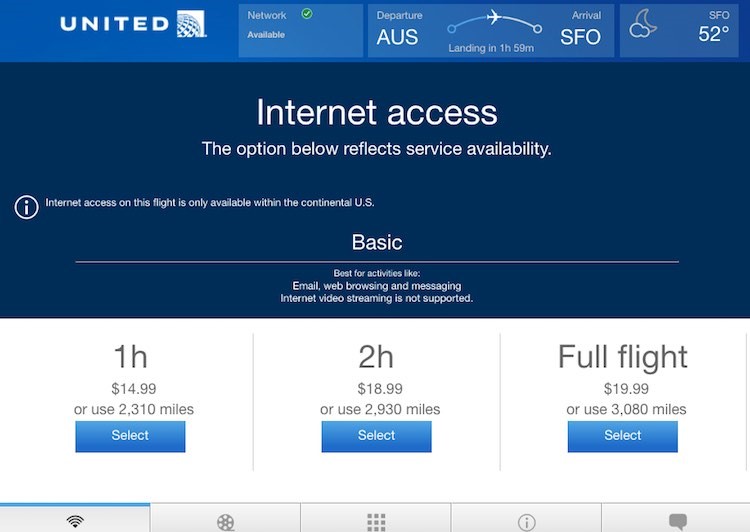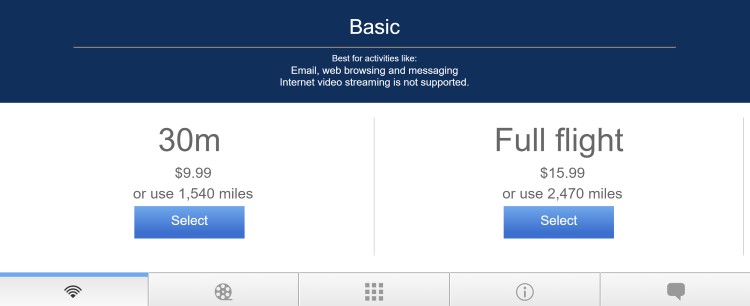Decoy Pricing: Did United Airlines Fire Their Behavioral Economist?
In just about every keynote I deliver, I illustrate a high-friction customer experience with examples from United.com, the website of United Airlines. I used to think the firm desperately needed to hire at least one UX or CX expert, but I’ve concluded they probably DO have people who know those fields. But, I also concluded, the people who know how to fix the site’s usability have far less power than the firm’s IT and security bosses. Despite those website misgivings, I have praised United for using smart behavioral economics, specifically their use of decoy pricing for their in-flight wifi.
Real World Decoy Pricing
In my recent post, Decoy Marketing, I used United as an example of how a business can encourage customers to select the more profitable of two products. Here’s what their pricing approach looked like when I wrote that post:

The two hour option looks redundant, but it serves a purpose. In this case, according to research by Dan Ariely and others, pricing the two hour option only a dollar less than the full-flight option should encourage more customers to purchase the latter.
A similar but slightly worse alternative makes the better option seem more attractive than if it was standing alone. Rational? No. But, that’s why Ariely put “irrational” in the title of his book.
Learn how adding a price point that makes no sense can INCREASE your sales. #pricing Share on XDespite the established science, it’s not particularly common to see such a clear-cut example of decoy pricing in use by a major firm. More often, one sees a high-end decoy. Even if customers don’t buy it, adding a very expensive option will make the previous top-of-the-line choice look like a reasonable compromise.
No More Decoy
With this backdrop, I was surprised on my most recent United flight to see rather conventional wifi pricing, with 30 minutes costing $9.99 and the full flight $15.99:

This was a shorter flight, just a couple of hours. That explains the lower cost option being a mere 30 minutes. But why not have a one-hour option for, say, $14.99? Or even $15.99, same as the full flight? “Worse but priced the same” was the approach Ariely took in his classic decoy pricing experiments.
Did some United executive look at the odd pricing in the first example and decide it didn’t make sense? (That’s the point of decoy pricing – the “worse” option doesn’t seem to make sense, and nobody buys it.) Did they fire their behavioral economist? A few other more charitable explanations occurred to me:
- The availability of wifi on this flight could be impacted by flying over water. Perhaps the one hour option was too risky to offer. If a customer saw the one hour option and bought the full flight, they might complain if they got less than an hour. Without that option, any amount of service over 30 minutes would qualify as a full flight, even if it wasn’t a great value.
- Perhaps A/B testing showed the two options maximized revenue, at least for shorter flights. I always caution audiences and clients to never blindly base important strategies on “best practices” or even well-established science. Every situation is different. Research provides a starting point, but it’s important to test, test, test.
I’ll give United the benefit of the doubt on this one. Perhaps there is a good reason for not including a decoy offer. (But no, their abysmal website experience won’t get a pass. I dread them finally fixing it, I’ll have to find a new set of bad CX examples.)
Brainfluence Takeaway
Whatever this difference in pricing means for United, there’s a lesson here for all marketers. A “logical” pricing progression isn’t always the approach that will maximize revenue or profit. As I describe in my decoy pricing article, introducing a less-than-rational choice may be just what you need to get your best results.
Related Articles
- More Decoys: Compromise Marketing
- Offer a Third Choice, Boost Sales
- Neuro-Menus and Restaurant Psychology
